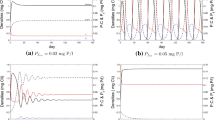Abstract
A re-examination of the numerical example of the three-compartment model by CONOVER & FRANCIS (1973) showed that the warning by these authors for the misuse of radio isotopes in transfer studies within food chains is incorrect and based on a misinterpretation of their results. There is no difference in the estimate of transfer rate by use of specific activities or by use of total radioactivities observed in each compartment.
After adapting the formulae developed by CONOVER & FRANCIS, their model was used to illustrate deviations of the programmed grazing rate in 3 types of grazing experiments; a) with14C present only in the phytoplankton at the start of the experiment, b) with14C only in the water, and c) with14C in both phytoplankton and water. Up to a duration of the grazing experiment of 2 hours, and at various light conditions and grazing pressures, deviations were small and did not exceed 4%. These results are not directly applicable to practical work because the quantitatively important loss by egestion of radioactive material was not accounted for, only losses by respiration were incorporated in the closed, steady-state model.
Best calculations of the community filtering rate (fraction of the volume of the grazing vessel swept clear per day) were generally obtained with the formula (with t in hours) ‘((DPM zoo at time t)/(DPM phyto at 0+DPM phyto at t)/2)×24/t’, applicable to all three types of grazing experiments considered.
Similar content being viewed by others
References
BAARS, M.A., & S.S. OOSTERHUIS, 1984. Diurnal feeding rhythms in North Sea copepods measured by gut fluorescence, digestive enzyme activity and grazing on labelled food. Neth. J. Sea Res., 18 97–119.
BAARS, M.A. & S.S. OOSTERHUIS, 1985. Zooplankton grazing in natural water with high concentration of14C bicarbonate: variable live controls and gut passage time of zooplankton. Hydrobiol. Bull., 19: 71–80.
CONOVER, R.J. & V. FRANCIS, 1973. The use of radioactive isotopes to measure the transfer of materials in aquatic food chains. Mar. Biol., 18: 272–283.
DARO, M.H., 1978. A simplified14C method for grazing measurements on natural planktonic populations. Helgoländer wiss. Meeresunters., 31: 241–248.
GULATI, R.D., 1985. Zooplankton grazing methods using radioactive tracers: technical problems. Hydrobiol. Bull., 19: 61–69.
GULATI, R.D., K. SIEWERTSEN & G. POSTEMA, 1982. The zooplankton: its community structure, food and feeding, and role in the ecosystem of Lake Vechten. Hydrobiologia, 95: 127–163.
LAMPERT, W., 1974. A method for determining food selection by zooplankton. Limnol. Oceanogr., 19: 995–998.
LAMPERT, W., 1975. A tracer study on the carbon turnover ofDaphnia pulex. Verh. Internat. Verein. Limnol., 19: 2913–2921.
LAMPERT, W. & W. GABRIEL, 1984. Tracer kinetics inDaphnia: an improved two-compartment model and experimental test. Arch. Hydrobiol., 100: 1–20.
NAUWERCK, A., 1959. Zur Bestimmung der Filtrierrate limnischer Planktontiere. Arch. Hydrobiol., Suppl., 25: 83–101.
PETERS, P.H., 1984. Methods for the study of feeding, grazing and assimilation by zooplankton. In: J.A. Downing and F.H. Rigler (eds.), A manual on methods for the assessment of secondary productivity in fresh waters. I.B.P. Handbook 17, 2nd ed. Blackwell, Oxford, p. 334–411.
Author information
Authors and Affiliations
Rights and permissions
About this article
Cite this article
Daro, M.H., Baars, M.A. Calculations of zooplankton grazing rates according to a closed, steady-state, three-compartment model applied to different14C methods. Hydrobiological Bulletin 19, 159–170 (1985). https://doi.org/10.1007/BF02270762
Issue Date:
DOI: https://doi.org/10.1007/BF02270762




